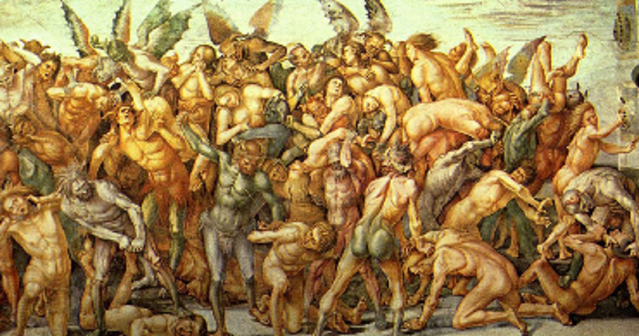Fantasies
Who Acts Out Aggressive Fantasies?
Aggressive fantasies may foster violent behavior in some people but not others.
Posted August 22, 2019 Reviewed by Matt Huston
Fantasy is often an important part of a person’s inner life, as it allows one to imagine alternative selves that are not constrained by reality. For some people, fantasies about violent and aggressive actions might be harmless. However, there is evidence that, at least for some people, having aggressive fantasies is linked to later aggressive behaviour.
Why some people choose to act out aggressive fantasies, while others do not, is not well understood. A recent study found links between aggressive fantasies, aggressive behaviour, and certain personality traits. Whether aggressive fantasies are acted out or not might depend on whether the fantasies are rooted in anger and resentment or if they simply reflect a vivid imagination instead.

Past research has found that people who frequently have aggressive fantasies (e.g. daydreaming about hurting somebody they don’t like) may be more likely to engage in actual aggressive and violent behaviour. For example, one study found that children who admitted to aggressive fantasies engaged in more aggressive behaviour, especially if they had been exposed to actual violence in the home (e.g. witnessing adults hitting each other) (Smith, Fischer, & Watson, 2009).
A more recent study (McCreery & Krach, 2018) examined how aggressive fantasies were related to specific personality traits, as well as proactive and reactive aggression (“cold” goal-oriented aggression vs. “hot” retaliatory responses to a perceived slight or provocation). The personality traits examined were those from the well-known Big 5 model: extraversion, agreeableness, conscientiousness, neuroticism, and openness to experience (called “intellect” in this study). Participants were recruited from social media websites.
The authors found, in line with previous research, that participants with more frequent aggressive fantasies admitted to higher levels of both proactive and reactive aggression. Additionally, they found that participants’ aggressive fantasies were associated with higher levels of openness to experience and neuroticism and lower levels of agreeableness. Regarding personality traits and aggressive behaviour, proactive aggression was predicted by higher extraversion and neuroticism, and lower agreeableness, while reactive aggression was predicted by higher neuroticism and lower agreeableness. Unfortunately, the authors did not explore whether personality traits would still predict aggressive behaviour when adjusting for differences in aggressive fantasies, and vice versa.
One theory about why aggressive fantasies might lead to aggressive actions is that fantasies can serve as scripts that allow the person to mentally rehearse behavioural patterns; actual behaviour may be elicited by environmental cues that match those in the fantasy (Gilbert & Daffern, 2017). Additionally, a person may imagine an action in considerable detail and consider ways to carry it out. Further, repeatedly focusing on violent thoughts may sustain feelings of anger and resentment, which might weaken a person’s inhibitions against performing violent actions for real.
That aggressive fantasies are related to low agreeableness and high neuroticism makes sense, because low agreeableness is associated with anger, hostility, and antagonism to other people, and is associated with “dark” traits, such as psychopathy, as well as antisocial behaviour in general (Jones, Miller, & Lynam, 2011). Neuroticism, on the other hand, is associated with a host of psychological problems, such as ruminating on distressing events and negative feelings in general. Low agreeableness and high neuroticism were also associated with both forms of aggressive behaviour in the study, so it might be that people who are prone to anger, resentment, and hard feelings are more likely to dwell on fantasies about hurting those who may have wronged them (reactive aggression) or who they think would be suitable victims (proactive aggression), and such fantasies might enable them to mentally rehearse aggressive behaviour that they later act out.
Although some people who have aggressive fantasies do go on to act them out, many others do not. In this regard, I found it interesting that McCreery and Krach found that openness to experience was associated with more frequent aggressive fantasies but was not associated with either proactive or reactive aggression. Openness is associated with being imaginative and having a rich inner life. People high in openness also tend to be high in a trait called absorption, which is the capacity to become totally immersed in an intense experience, and which is also associated with creativity.
A previous study (Bartels, Harkins, & Beech, 2017) found that men who had a rich fantasy life in general (e.g. had vivid mental imagery and were prone to becoming immersed in imaginary experiences) also tended to have more aggressive sexual fantasies, although the study did not examine whether they were also prone to more sexually aggressive behaviour. The authors of this study also noted that previous research found that people prone to daydreaming also tend to have richer sexual fantasy content in general. The authors suggested that the ability to imagine and form mental imagery is associated with richer fantasies in general, which includes aggressive sexual fantasies.
The finding by McCreery and Krach that higher openness to experience was associated with more frequent aggressive fantasies might similarly reflect that people high in openness are more imaginative and have richer fantasy lives in general. The fact that people high in openness to experience are not more prone to acting aggressively in real life might indicate that for these people, aggressive fantasies are not necessarily an expression of anger or desire to hurt others, but might have some other function. This might be as simple as mental entertainment, although it could be something more sophisticated, such as expressing their creativity by imagining diverse scenarios that are unconstrained by social norms.
McCreery and Krach’s findings might indicate that aggressive fantasies are driven by two distinct, broad factors: one related to anger and negative emotion, which fosters rehearsal of aggressive scripts that can motivate violent action; the other factor related to imagination and the exploration of creative scenarios as part of a rich inner life.

In summary, although it is not entirely clear why some people are prone to act on aggressive fantasies while others do not, the research suggests a few clues. Specifically, in people who are prone to anger, resentment, and hostility, aggressive fantasies might be an additional risk factor for violent behaviour. On the other hand, in people who are not particularly angry but who have a vivid imagination, aggressive fantasies might be a harmless part of their inner life.
Of course, even considering all this, it is worth pointing out that even people who are disagreeable and neurotic may not necessarily act on their darker impulses, no matter how much they fantasize about them. Perhaps future studies might explore protective factors that mitigate against the harmful effects of aggressive fantasies, such as anger management strategies. Conversely, risk factors that could weaken people’s inhibitions against violent behaviour also need to be considered. For example, one study found that people who not only have aggressive fantasies but who also drink alcohol heavily were at the most risk of engaging in aggressive and violent behaviour (Watt, Kohphet, Oberin, & Keating, 2013).
I would also like to mention in passing that, contrary to popular opinion, studies have found that expressing anger through venting and ranting, far from having a cathartic effect, actually seems to increase existing anger, and may increase the likelihood of expressing anger in maladaptive ways (Bushman, 2002; Martin, Coyier, VanSistine, & Schroeder, 2013). Like aggressive fantasies, venting and ranting may keep one’s attention focused on violent thoughts, which may prevent one from expressing one’s anger constructively, something I explored in a previous post.
© Scott McGreal. Please do not reproduce without permission. Brief excerpts may be quoted as long as a link to the original article is provided.
Facebook image: Nomad_Soul/Shutterstock
References
Bartels, R. M., Harkins, L. D., & Beech, A. R. (2017). The Influence of Fantasy Proneness, Dissociation, and Vividness of Mental Imagery on Male’s Aggressive Sexual Fantasies. Journal of Interpersonal Violence, 886260517691523. https://doi.org/10.1177/0886260517691523
Bushman, B. J. (2002). Does Venting Anger Feed or Extinguish the Flame? Catharsis, Rumination, Distraction, Anger, and Aggressive Responding. Personality and Social Psychology Bulletin, 28(6), 724–731. https://doi.org/10.1177/0146167202289002
Gilbert, F., & Daffern, M. (2017). Aggressive scripts, violent fantasy and violent behavior: A conceptual clarification and review. Aggression and Violent Behavior, 36, 98–107. https://doi.org/10.1016/j.avb.2017.05.001
Jones, S. E., Miller, J. D., & Lynam, D. R. (2011). Personality, antisocial behavior, and aggression: A meta-analytic review. Journal of Criminal Justice, 39(4), 329–337. https://doi.org/10.1016/j.jcrimjus.2011.03.004
Martin, R. C., Coyier, K. R., VanSistine, L. M., & Schroeder, K. L. (2013). Anger on the internet: The perceived value of rant-sites. Cyberpsychology, Behavior and Social Networking, 16(2), 119–122. https://doi.org/10.1089/cyber.2012.0130
McCreery, M. P., & Krach, K. S. (2018). How the human is the catalyst: Personality, aggressive fantasy, and proactive-reactive aggression among users of social media. Personality and Individual Differences, 133, 91–95. https://doi.org/10.1016/j.paid.2017.06.037
Smith, C. E., Fischer, K. W., & Watson, M. W. (2009). Toward a refined view of aggressive fantasy as a risk factor for aggression: Interaction effects involving cognitive and situational variables. Aggressive Behavior, 35(4), 313–323. https://doi.org/10.1002/ab.20307
Watson, D., Stanton, K., Khoo, S., Ellickson-Larew, S., & Stasik-O’Brien, S. M. (2019). Extraversion and psychopathology: A multilevel hierarchical review. Journal of Research in Personality, 81, 1–10. https://doi.org/10.1016/j.jrp.2019.04.009
Watt, B. D., Kohphet, A., Oberin, D., & Keating, S. (2013). The Relationship Between Violent Fantasy and Alcohol Misuse in Aggressive Behaviours. Australian Psychologist, 48(6), 452–458. https://doi.org/10.1111/ap.12011




